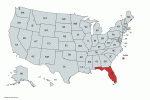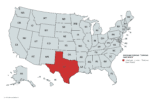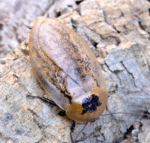Rear part of an insect’s body. Contains the sex organs.
Archives: Invertebrates
Description.
Adventive
A species that is not native but has become established to an area.
Aeluropoda insignis ”Flat Body Hisser
Apterous
Lacks wings.
Archimandrita tesselatta “Peppered Roach”


The Peppered Roach, hailing from northern South America and Central America is a large beautiful roach.
Housing: Tall and roomy with vertical bark or egg crate for molting and hanging out.
Food: Any food. They love fish flakes, bananas and oranges but will eat anything if in the mood. Hardwood leaves like Oak or Pecan are very important to their diet and longevity.
Temp Requirements: 70 to 85 Degrees
Breeding: Ovoviviparous
Substrate: Damp and about 3 inches deep. Coconut coir works well.
Difficulty Rating: Mid-range difficult because of the need for molting space hardwood leaves, moisture and length of time that it takes for nymphs to mature.
Size: They grow to 2 to 3 inches Humidity: Damp substrate and humid air.
Climbing/Flying Ability: Cannot climb nor fly
Peppered Roaches are a large roach that is very easy to handle. They are meaty and dense with a very calm demeanor. They will eat many different types of fruits, vegetables and fish flakes. They will also eat dry dog food. Nymphs take a while to grow and they are very small at first, but they are very much a great roach to add to any collection.
Arenivaga floridensis ”Florida Sand Roach”

Arenivaga tonkawa ”Tonkawa Sand Roach”
Arenivaga tonkawa
”Tonkawa Sand Roach”

The Tonkawa Sand Roach indigenous to the southwestern deserts of North America and from the great state of Texas, not to be confused with the not so great state of Taxes, which is where I am from.
They are sexually dimorphic with the males fully winged and females wingless.
In Spite of the word “sand” in their name, sand roaches do best in a substrate of crushed leaf litter, coconut fiber or peat moss, with little to no sand. In fact, if kept in coarse sand (think sandpaper) the roaches tend to dessicate and die.
In nature, they typically inhabit the upper layer of detritus that accumulates in rodent burrows.
They feed almost entirely on dried leaves and consume very little food in general. Dog food or fish flakes can be provided occasionally for protein.
This desert dweller does require regular slight moisture which mimics the cooler, moist conditions often found in rodent burrows, which are a couple of feet below the dry, hot surface of the desert.
This is a sensitive species and is recommended for advanced hobbyists. Adults reach approximately 1/2 an inch.
Armadillidium Maculatum “Zebra” isopod
Arolium
Terminal pad between the claws bottom most part of the leg which is known as the Tarsus.
Autotomy
A reflex where the invertebrate releases and appendage from a regrowth point. This often happens when a Roach, for instance is attacked or stressed.





